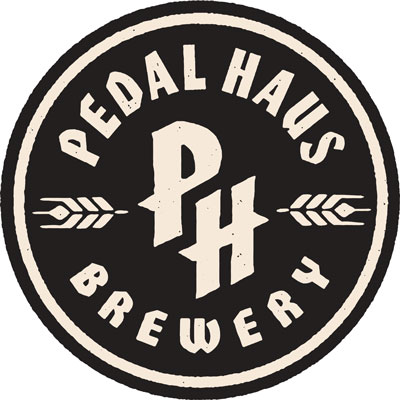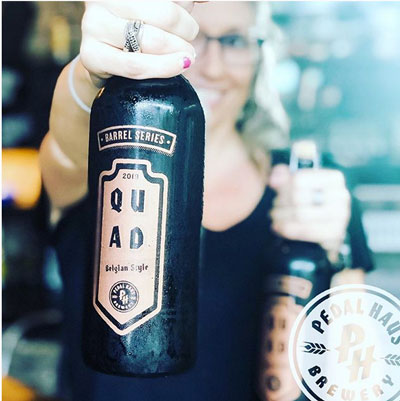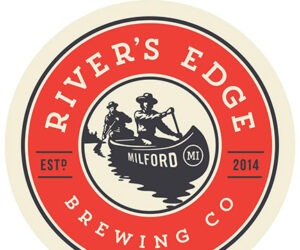Pedal Haus Brewery
Dear Replicator,
Work travel frequently takes me to the Phoenix, Arizona area and I try to get to Pedal Haus Brewery whenever possible. Their beers are always on point stylistically. Whether they’re Belgians, German-style lagers or a good, old-fashioned American IPA, the beers are clean, flavorful, and memorable. One beer that stood out to me was a Bourbon barrel-aged quad. The beer was wonderfully complex, containing all the expected fruit and rich malt flavors of a traditional Belgian dark strong ale, with the interesting additional character delivered by the barrels. This especially is one I’d like to try to replicate at home. Any advice how I might pull that off?
Dan Sevic
Olmsted Twp., Ohio
Thanks Dan! I have to say you have great taste in beer. I happen to know the Brewmaster at Pedal Haus Brewery, Derek Osborne alias Doc, and I agree that his beers are always on point. In fact, when I wrote the book, Phoenix Beer, A History Rising to New Peaks, I suggested that his Belgian wit (Biere Blanche) was actually the finest beer being produced in Phoenix at the time. But I digress . . . let’s talk about his Belgian quad, another stellar beer.
Pedal Haus Brewery is a star in Arizona’s craft beer industry. The brainchild of serial restaurant entrepreneur Julian Wright, Pedal Haus Brewery is one of the jewels in Wright’s lineup of establishments, due in part to the fact that he found himself a technically proficient brewer. The brewing medals Doc has garnered through the years speak volumes about his capabilities.
After walking away from a career path as a chiropractor, Doc spent many years working with BJ’s Brewhouse, first in California then onto Oregon then Colorado, before settling down permanently in Arizona in 2001 to head up their Chandler location. Respected by most everyone in the brewing community, Doc accomplished so much during his tenure at BJ’s except for one fleeting dream — being a brewery owner.

When approached by Wright to consult on his new brewing project, the two hit it off and the consultation progressed. It wasn’t long before Wright offered Doc the job as his full-time Brewmaster, along with an ownership stake to join his new venture. After a heartfelt discussion with his wife, Melissa, also a professional brewer with Four Peaks Brewing Co. in Tempe, Arizona, the couple decided to take the plunge and Doc became part of the Pedal Haus team.
Located in the heart of Mill Avenue, ground zero for the students of Arizona State University, Pedal Haus debuted as a Belgian-inspired restaurant/brewery. However, the concept didn’t quite fit the largely college audience who wanted more familiar options such as light lagers and American IPAs, neither of which were brewed when Pedal Haus first opened. Just a year into its existence, Wright decided on a pivot and closed doors for a complete rebuild and rebranding. Pedal Haus 2.0 is more closely aligned with what the local college demographic was seeking.
While that may have meant light lagers and IPAs being added to the beer list, it did not take away from Brewmaster Osborne’s strengths, which include brewing European classic styles including Belgian favorites. Having drunk his fair share of LaTrappe quads over the years, Doc found inspiration and wanted to try his hand at one of his own, but with a twist.
He starts this beer off with a traditional quadrupel recipe. What some people call quads, others call Belgian dark strong ales, but essentially, we are talking about the same thing here. Brimming with dark fruit notes of plum, fig, and cherries, he gives it an extra level of complexity by aging it in barrels. At first, this annual brew was aged exclusively in Bourbon barrels, but as the years went by, Osborne worked wine barrels into the mix to impart different and unique character to the beer. The barrel aging — Bourbon, wine, or otherwise — is not meant to steal the show, rather to impart additional complexity. This is still a Belgian dark strong ale at heart. However, the barrels provide notes of oak, vanilla, and naturally, Bourbon, to take a complex beer to an entirely new level. The results are an amalgam of malt, yeast, and barrel bliss.
It’s a beer big in all regards: Aroma, flavor, mouthfeel, and alcohol. The beer has a full body, with enough carbonation (2.8 v/v) to give it a “lighter than it really is” feel to it. Though the alcohol is strong at 10.6% ABV, it is just one of many components to this complex beer that blend into the whole instead of standing out by itself. The Westmalle yeast strain imparts a traditional Belgian yeast profile while the character malts such as dark Munich, dark crystal, and Simpsons DRC (double roasted crystal), add to the bready, dark fruit, and malty sweet essence that is the signature of a Belgian dark strong. Despite the burst of sugar upfront, the beer finishes fairly dry, thanks in part to the barrels, with no cloying aftertaste.
For those unfamiliar, classic examples of the Belgian dark strong style include Gulden Draak, St. Bernardus 12, Rochefort 10, Chimay Blue, and if you’re lucky enough to get your hands on it, Westvleteren 12. Pair this beer with a hearty meal such as BBQ brisket or pulled pork, or even a thick, juicy steak. Post dinner there is no better pairing than a Belgian dark strong ale and a fine cigar. But before you worry about pairings, it’s time to get brewing and create your version of this big and bold beer from Pedal Haus Brewery. Prost!
PEDAL HAUS BREWERY’S BARREL-AGED QUAD CLONE

(5 gallons/19 L, all-grain)
OG = 1.094 FG = 1.011
IBU = 18 SRM = 19 ABV = 10.6%
Ingredients
13 lbs. (5.9 kg) 2-row pale malt
11 oz. (0.25 kg) dark Munich malt (30 °L)
5.5 oz. (160 g) melanoidin malt
12.5 oz. (0.35 kg) Simpsons DRC malt
3 oz. (84 g) crystal malt (75 °L)
1 oz. (28 g) acidulated malt
1.6 lbs. (0.73 kg) dextrose (corn sugar)
0.63 lbs. (0.29 kg) amber candi syrup
0.63 lbs. (0.29 kg) amber dried malt extract
3.3 AAU Magnum hops (90 min.) (0.25 oz./7 g at 13.1% alpha acids)
2 AAU Magnum hops (40 min.) (0.15 oz./4 g at 13.1% alpha acids)
1 oz. (28 g) American oak chips (Bourbon-soaked)
Wyeast 3787 (Belgian High Gravity), White Labs WLP530 (Abbey Ale), or Mangrove Jack’s M41 (Belgian Ale) yeast
7⁄8 cup corn sugar (if priming)
Step by Step
In advance of brew day, submerge your oak chips in your favorite Bourbon for a minimum of two weeks.
Using a thick mash of 1.25 qts./lb. (2.6 L/kg) of grain, mix grains (not the sugars) with 4.66 gallons (17.6 L) of water. Mash in, targeting an initial temperature at 112 °F (44 °C) for a beta glucan rest. Once the grain is added, add 1 tsp. of gypsum and a ½ tsp. of calcium chloride. Hold at this temperature for 20 minutes. Raise temperature to 149 °F (65 °C) and hold at this rest for 20 minutes. Raise temperature to 158 °F (70 °C) and hold for 30 minutes. Once mash is complete, mashout for 10 minutes at 170 °F (77 °C).
Recirculate until clear, and then begin collecting wort. With the goal of achieving 5.5 gallons (20.8 L) of wort after boil (which will yield a 5-gallon/19-L batch), collect 7.9 gallons (29.8 L) of wort since this beer requires a long boil. The 120-minute boil is necessary to develop the depth of malt flavor while also helping with color development. Add the malt extract and the first hops addition at the 90-minute mark, then the second hop addition at the 40 minute mark. Add the sugar and syrup in the last 5 minutes of the boil. Whirlpool vigorously and let settle for 20 minutes before chilling.
Chill the wort to 66 °F (19 °C). Pitch your yeast starter and oxygenate thoroughly. Primary fermentation should take five days. Upon completion of primary, raise the temperature to 72 °F (22 °C) and add your Bourbon-soaked oak chips to replicate barrel aging. Hold at this temperature for 21 more days to fully develop the complex flavors of the beer. (Note: If fermentation stalls well short of the goal, it’s OK to pitch a second helping of neutral yeast, such as SafAle US-05, WLP001 or Wyeast 1056. Just do not oxygenate during the second pitching. If you do a second yeast pitch, give that five days to finish primary then begin the secondary fermentation process mentioned above.) When fermentation is complete, bottle or keg and carbonate to 2.8 v/v.
PEDAL HAUS BREWERY’S BARREL-AGED QUAD CLONE
(5 gallons/19 L, partial mash)
OG = 1.094 FG = 1.011
IBU = 18 SRM = 19 ABV = 10.6%
Ingredients
7.5 lbs. (3.4 kg) Briess pale ale dried malt extract
11 oz. (0.25 kg) dark Munich malt (30 °L)
5.5 oz. (160 g) melanoidin malt
12.5 oz. (0.35 kg) Simpsons DRC malt
3 oz. (84 g) crystal malt (75 °L)
1.6 lbs. (0.73 kg) dextrose (corn sugar)
0.63 lbs. (0.29 kg) amber candi syrup
0.63 lbs. (0.29 kg) amber dried malt extract
3.3 AAU Magnum hops (60 min.) (0.25 oz./7 g at 13.1% alpha acids)
2 AAU Magnum hops (40 min.) (0.15 oz./4 g at 13.1% alpha acids)
1 oz. (28 g) American oak chips (Bourbon-soaked)
Wyeast 3787 (Belgian High Gravity), White Labs WLP530 (Abbey Ale), or Mangrove Jack’s M41 (Belgian Ale) yeast
7⁄8 cup corn sugar (if priming)
Step by Step
In advance of brew day, submerge your oak chips in your favorite Bourbon for a minimum of two weeks.
Bring 2 gallons (7.6 L) up to about 160 °F (70 °C). Place all the pale, Munich, and melanoidon malts in a muslin bag and steep for about 30 minutes. Add the crystal malts to a separate muslin bag and steep in the wort for an additional 15 minutes (45 minutes total). After, place all the grains in a colander and wash with 2 gallons (7.6 L) of hot water. Raise the temperature to near-boiling, then remove from heat and add the two malt extracts while stirring vigorously. Return to a boil and boil 60 minutes adding the hops as indicated, and add the sugar and syrup in the last 5 minutes of the boil.
Once the boil is complete, top up with water with the goal of achieving 5.5 gallons (20.8 L) of wort, which will yield a 5-gallon (19-L) batch after fermentation is complete. Follow the remaining all-grain instructions for fermentation and packaging.
Tips For Success:
For the malts, Derek “Doc” Osborne uses Simpsons DRC, which is very similar to Special B malt. Substitute if the Simpsons DRC is unavailable. If you cannot find Munich 30 °L, using dark Munich at 20 °L will suffice. Crystal 75 can be exchanged for Crystal 77 or Crystal 80, depending on what is available to you.
Anytime you are brewing beers >10% ABV, fermentation control is of the utmost importance. The yeast has to work really hard to ferment this much sugar, and temperatures can rise quickly, producing alcohols with higher molecular weight that can leave off-flavors in your beer. It’s vital to pitch enough yeast and oxygenate thoroughly to ensure the yeast can do its job. Also oxygenate for a couple minutes. Doc says it’s okay to add an additional burst of oxygen on day two as long as alcohol production has not yet started. This second oxygen addition can give the boost it needs to tackle such a big beer.



